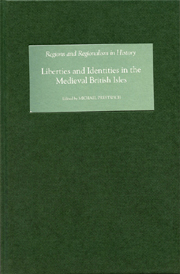Book contents
- Frontmatter
- Contents
- List of maps
- Abbreviations
- Introduction
- 1 States, liberties and communities in medieval Britain and Ireland (c.1100–1400)
- 2 Arbitration and Anglo-Scottish border law in the later middle ages
- 3 Peacekeepers and lawbreakers in medieval Northumberland, c.1200–c.1500
- 4 War, lordship, and community in the liberty of Norhamshire
- 5 The lordship of Richmond in the later middle ages
- 6 ‘Tam infra libertates quam extra’: Liberties and military recruitment
- 7 Neighbours from Hell? Living with Tynedale and Redesdale, 1489–1547
- 8 Striving for Marcher liberties: The Corbets of Caus in the thirteenth century
- 9 Franchises north of the border: Baronies and regalities in medieval Scotland
- 10 The liberties of Ireland in the reign of Edward I
- Index
1 - States, liberties and communities in medieval Britain and Ireland (c.1100–1400)
Published online by Cambridge University Press: 12 September 2012
- Frontmatter
- Contents
- List of maps
- Abbreviations
- Introduction
- 1 States, liberties and communities in medieval Britain and Ireland (c.1100–1400)
- 2 Arbitration and Anglo-Scottish border law in the later middle ages
- 3 Peacekeepers and lawbreakers in medieval Northumberland, c.1200–c.1500
- 4 War, lordship, and community in the liberty of Norhamshire
- 5 The lordship of Richmond in the later middle ages
- 6 ‘Tam infra libertates quam extra’: Liberties and military recruitment
- 7 Neighbours from Hell? Living with Tynedale and Redesdale, 1489–1547
- 8 Striving for Marcher liberties: The Corbets of Caus in the thirteenth century
- 9 Franchises north of the border: Baronies and regalities in medieval Scotland
- 10 The liberties of Ireland in the reign of Edward I
- Index
Summary
The study of medieval England's liberties, franchises, immunities or so-called ‘private’ jurisdictions has become less fashionable than used to be the case. The investigations of Warren Ault, Helen Cam, Noel Denholm-Young, and Naomi Hurnard, from the 1920s to the 1950s, were supplemented and refined in a series of local studies by, among others, Geoffrey Barraclough, Robin Du Boulay, Constance Fraser, Edward Miller, and Jean Scammell. Generally such work paid scant attention to those now familiar themes ‘community’ and ‘identity’; it centred on institutional theory and practice; and it set the history of liberties firmly within a paradigm of assimilation into the apparatus of English royal government. ‘Their inflated reputations’, as one authority concluded, ‘falsify many assessments of the effectiveness of monarchy and the possible extent of immunities in medieval England.’ The effect was to relegate liberties to the historical sidelines; and that links with more recent trends in English medieval historiography, which have tended to prioritise other power structures, notably the royal county and, above all, the state. It is quite otherwise when we shift our focus from England to the rest of the British Isles, and – thanks largely to the work of Rees Davies and Robin Frame – especially to Wales and Ireland.
- Type
- Chapter
- Information
- Publisher: Boydell & BrewerPrint publication year: 2008



